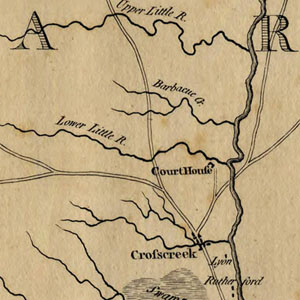Arguments about the etymology of the word barbecue can be as contentious as discussions about what goes into the sauce. The word almost certainly comes from the Spanish word barbacoa, though there have been plenty of other guesses through the years. One of the most popular theories is that it comes from the French barbe à queue, meaning “beard to tail.” This origin is embraced by those who insist that real barbecue is made with the whole hog, rather than just the shoulder. However, the typically sedate Oxford English Dictionary huffs that the French origin is “an absurd conjecture suggested merely by the sound of the word.”
The first use of the word barbecue in English, at least as spotted by the OED, is from Edmund Hickeringill’s 1661 narrative, Jamaica Viewed. That’s fine, but what I want to know is, when did it first appear on a map? I submit as a contender this detail here, from Henry Mouzon’s 1775 “Accurate Map of North and South Carolina With Their Indian Frontiers”:

Look closely — the branch north of Courthouse is labeled “Barbacue Cr.” The area shown is covered by present-day Cumberland and Harnett Counties (“Crosscreek,” at the bottom of the image, was renamed Fayetteville in 1783). Barbecue Creek is located in Barbecue Township, also home to the Barbecue Church, established in 1757. I’ve never visited Barbecue Creek, but I imagine a clear stream redolent of vinegar and smoke. Located in eastern North Carolina, it would, of course, be entirely tomato free.
